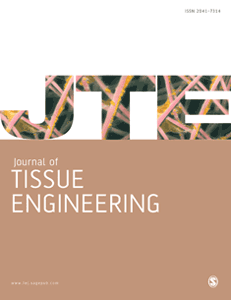Mechanisms of hydrogel-based microRNA delivery systems and its application strategies in targeting inflammatory diseases
IF 7
1区 工程技术
Q1 CELL & TISSUE ENGINEERING
引用次数: 0
Abstract
Hydrogels, composed of three-dimensional polymer networks, are excellent delivery carriers and have been extensively employed in the biomedical field. Inflammation acts as a protective mechanism to prevent harmful substances from entering living organisms, but chronic, long-lasting inflammation can cause oxidative stress, which damages tissue and organs and adversely affects patients’ quality of life. The aberrant expression of microRNAs (miRNAs) has been found to play a significant part in the etiology and progression of inflammatory diseases, as suggested by growing evidence. Numerous hydrogels that can act as gene carriers for the intracellular delivery of miRNA have been described during ongoing research into innovative hydrogel materials. MiRNA hydrogel delivery systems, which are loaded with exogenous miRNA inhibitors or mimics, enable targeted miRNA intervention in inflammatory diseases and effectively prevent environmental stressors from degrading or inactivating miRNA. In this review, we summarize the classification of miRNA hydrogel delivery systems, the basic strategies and mechanisms for loading miRNAs into hydrogels, highlight the biomedical applications of miRNA hydrogel delivery systems in inflammatory diseases, and share our viewpoints on potential opportunities and challenges in the promising region of miRNA delivery systems. These findings may provide a new theoretical basis for the prevention and treatment of inflammation-related diseases and lay the foundation for clinical translation.基于水凝胶的 microRNA 递送系统的机理及其在炎症性疾病中的应用策略
水凝胶由三维聚合物网络组成,是一种优良的输送载体,已被广泛应用于生物医学领域。炎症是防止有害物质进入生物体的一种保护机制,但长期慢性炎症会导致氧化应激,从而损害组织和器官,对患者的生活质量产生不利影响。越来越多的证据表明,微小核糖核酸(miRNA)的异常表达在炎症性疾病的病因和进展中起着重要作用。在对创新水凝胶材料的持续研究过程中,发现了许多可作为基因载体在细胞内递送 miRNA 的水凝胶。装载了外源 miRNA 抑制剂或模拟物的 MiRNA 水凝胶递送系统能对炎症性疾病进行有针对性的 miRNA 干预,并有效防止环境应激源降解或使 miRNA 失活。在这篇综述中,我们总结了 miRNA 水凝胶递送系统的分类、将 miRNA 加载到水凝胶中的基本策略和机制,强调了 miRNA 水凝胶递送系统在炎症性疾病中的生物医学应用,并就 miRNA 递送系统这一前景广阔的领域中潜在的机遇和挑战分享了我们的观点。这些发现可能为预防和治疗炎症相关疾病提供新的理论依据,并为临床转化奠定基础。
本文章由计算机程序翻译,如有差异,请以英文原文为准。
求助全文
约1分钟内获得全文
求助全文
来源期刊

Journal of Tissue Engineering
Engineering-Biomedical Engineering
CiteScore
11.60
自引率
4.90%
发文量
52
审稿时长
12 weeks
期刊介绍:
The Journal of Tissue Engineering (JTE) is a peer-reviewed, open-access journal dedicated to scientific research in the field of tissue engineering and its clinical applications. Our journal encompasses a wide range of interests, from the fundamental aspects of stem cells and progenitor cells, including their expansion to viable numbers, to an in-depth understanding of their differentiation processes. Join us in exploring the latest advancements in tissue engineering and its clinical translation.
 求助内容:
求助内容: 应助结果提醒方式:
应助结果提醒方式:


